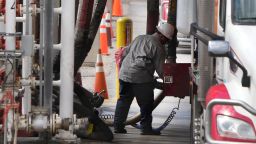A benchmark measure of inflation slowed in July after surging in the previous month, offering a glimmer of hope that the painful inflation Americans are facing could moderate in the coming months.
The Producer Price Index, which captures prices paid to producers for their goods and services, was 9.8% higher in July, compared with a year earlier. That’s a slowdown from a sharp 11.3% year-over-year spike in June, according to data released Thursday by the Bureau of Labor Statistics.
On a monthly basis, wholesale prices fell by 0.5%, downfrom a revised 1% month-over-month increase in June.
The report comes one day after the closely watched Consumer Price Index for July showed that the prices Americans pay for everything from food to electricity increased by 8.5% over the past year, a slower pace than the 9.1% increase in June.
“If you combine this with the Consumer Price Index news, which was certainly much more encouraging than would have been expected, this gives us hope that the worst of the inflation pressures are behind us,” said Mark Hamrick, senior economic analyst at Bankrate.
Largely attributed to a cooling-off of record-high energy prices, these lower numbers are generally seen as a sign of progress in the fight against inflation. However, economists warn that yet another hotinflation report sends a strong signal that the economy is not out of the inflationary woods yet.
Producer prices are generally more volatile than consumer prices, since cost fluctuations generally don’t get wholly passed through to consumers. But these expenses are partially reflected in what Americans pay for goods and services, and a high number is generally viewed as a harbinger of rising prices on consumer goods.
Eric Sterner, chief investment officer at Apollon Wealth Management, said falling wholesale prices bode well for consumers sufferingsticker shock.
“This is definitely welcome news,” he said. “I think this is an even more valuable reading than CPI, because this is a leading indicator of what consumers will see in the future. We’re far from out of the woods, but we’re heading in the right direction.”
Energy moves the needle
The fall in sky-high energy prices gets much of the credit for the lower inflation readings. The BLS said July’s 1.8% drop in wholesale goods prices – the largest monthly decline since a lockdown-triggered plunge in April 2020 – is a function of lower energy prices. The agency also attributed 80% of the price decline in goods to a 16.7% drop in gasoline prices from June to July.
Prices at the pumphit a symbolic threshold on Thursday, falling below $4 a gallon for the first time since March. Nationwide, the average price for a gallon of gas was $3.99, according to AAA, which attributed at least some of the drop to cooling demand.
“What it reflects is that gasoline demand is maybe a little bit more elastic than people think,” said Stewart Glickman, energy equity analyst at CFRA Research, noting that Americans have been driving less in response to the rapid jump in prices at the pumpin the spring and early summer.
Aside from gasoline, oil-related products ranging from jet fuel to diesel to petroleum-derived plastics play an enormous role in making and transporting goods of all kinds. For better or worse, oil prices have a more profound impact on prices than most people appreciate, Glickman said.
“The fact that anything you buy at the store or get shipped to you – someone is paying for the movement of those goods,” he said. “It works its way into the cost of lots of things that we consume. It’s influential beyond just when you roll up to the pump and need to fill up again.”
A needle for the Fed to thread
While this week’s slew of inflation datareflects incremental improvement, the US economy remains in a highly challenging environment, with rising prices a continued concern for businesses and policymakers.
“We’ve still got a long way to go to get inflation back to a normalized rate,” Sterner said.
That raises the stakes for the Federal Reserve, which has committed to raising interest rates to tame inflation and is trying to avoid triggering a recession in the process.
The central bank’s rate-setting committee, whose next meeting is in September, will have to parse data that sometimes appears contradictory: The labor market added a blowout 528,000 jobs in July, but weekly jobless claims have begun to climb. Wages are rising at a rate of greater than 5% annually, but labor force participation remains lackluster. Surveys of consumers and small businesses indicate negative sentiment, but spending has, by and large, held up.
Most analysts now expect the Fed to hike rates by 50 basis points (half a percentage point) next month, following historic, back-to-back 75 basis-point hikes. As recently as Monday, a strong majority was projecting a 75-point jump.
With more than a month to go before Fed policymakers reconvene, Hamrick said the wild ride for rate expectations is likely to continue.
“The Fed has been on a journey here trying to get their interest rate adjustments just right,” he said. “They’re essentially having to make this up as they go along, more so than they have in the past, because it’s such an uncertain and volatile environment.”








